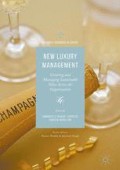Abstract
In the past, tangible assets (manufacturing assets, land, buildings and financial assets) were regarded as the main source of business value. However, economic and market conditions in the last quarter of the twentieth century have shown that a company’s value is not made up of its tangibles alone. Both markets and academia have recognized that intangibles are one of the main sources of value creation, and a factor in explaining the gap between some companies’ market and book (or accounting) values.
Access this chapter
Tax calculation will be finalised at checkout
Purchases are for personal use only
Notes
- 1.
See Chap. 4.
- 2.
IAS 36—impairment tests.
- 3.
- 4.
International Accounting Standards—International Financial Reporting Standards.
- 5.
IAS 38—intangible assets.
- 6.
This is done annually through an impairment test (IAS 36).
- 7.
For any merger or acquisition before 2004, the brand value at the time of the operation is included in the goodwill.
- 8.
See income split method in this chapter.
- 9.
For example, www.royaltysource.com.
- 10.
J-N Kapferer, The New Strategic Brand Management, Kogan Page Ltd. 2011, 5th edition.
- 11.
References
B. Lev, P. Zarowin (1999), “The Boundaries of Financial Reporting and How to Extend Them”, Journal of Accounting Research, Vol. 37 No. 2 Autum.
D. A. Aaker (1991), Managing brand equity: Capitalizing on the value of a brand name, Free Press.
G. Hawanini, and C. Viallet, Finance for Executives; Maison (Ohio) SouthWestern Cengage Learning, 2011, 4th edition.
J-N. Kapferer, The New Strategic Brand Management, Advanced Insight and Strategy Thinking; London, Kogan Page Ltd, 2011, 5th edition.
H. Philippe, L. Paugham, and D. Aguilar, Evaluation Financière de la Marque, Economica, 2014.
H. A. Robin, S. A. Murphy, “Using recall and brand preference to evaluate advertising effectiveness”, Journal of Advertising Research, Vol 31(2), Apr–May 1991, 56–63.
G. Michel, Management transversal de la marque, Dunod, 2014.
R. Abratt, and G. Bick (2003), “Valuing Brand and Brand Equity: Methods and Processes”, Journal of Applied Management and Entrepreneurship.
Author information
Authors and Affiliations
Corresponding author
Editor information
Editors and Affiliations
Rights and permissions
Copyright information
© 2017 The Author(s)
About this chapter
Cite this chapter
García, M.R. (2017). Financial Valuation of Luxury Brands. In: Rigaud-Lacresse, E., Pini, F. (eds) New Luxury Management. Palgrave Advances in Luxury. Palgrave Macmillan, Cham. https://doi.org/10.1007/978-3-319-41727-1_6
Download citation
DOI: https://doi.org/10.1007/978-3-319-41727-1_6
Published:
Publisher Name: Palgrave Macmillan, Cham
Print ISBN: 978-3-319-41726-4
Online ISBN: 978-3-319-41727-1
eBook Packages: Business and ManagementBusiness and Management (R0)

